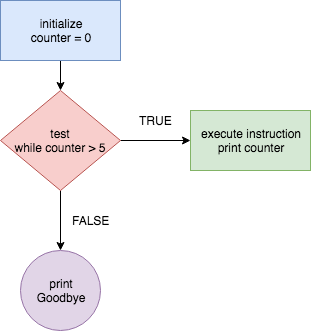Week 2: Session 2
Looping, Data Structures, and Functions
Activity 1: Review Week 2 Session 1
- Variables
- Decision making in a program
- Logical operators
- Logical expresssions
Activity 2: Demo how to create a guessing game Challenge that uses Looping
Identify sections of the Adventure Game framework that loop. Show
how the loop is intiated
what keeps it going
how the loop is terminated
Activity 3: Make a Flow chart
Flow charts are used when designing code

Activity 4: Write code for loops
Code sample for while loop
count = 0 # initialize
while (count < 5): # test to decide if we should quite
print ('The count is:', count) # execute instruction
count = count + 1 # increment counter
print ("Good bye!") # print good by when done with loop
Break out of a while loop early
count = 0 # initialize
while (count < 5): # test to decide if we should quite
print ('The count is:', count) # execute instruction
count = count + 1 # increment counter
if count == 3:
break;
print ("Good bye!") # print good by when done with loop
An infinite while loop - it runs forever - it has nothing to stop it
var = 1
while var == 1 : # This constructs an infinite loop
num = raw_input("Enter a number :")
print "You entered: ", num
print "Good bye!"
Code sample for for loop
fruits = ["apple", "banana", "cherry"]
for x in fruits:
print(x)
for x in range(5):
print(x)
Exercise:
Write a flow chart for a for loop
Create a while loop
Create a for loop
Describe the difference between a for loop and a while loop
Activity 5: Python Data Structures
List: an ordered structure
animals = ['cat','dog','chicken','cow']
for animal in animals:
print (animal, len(animal))
List: can be accessed by number and numbers start at 0
What animal get's printed with this instruction? What do "square brackets" do?
print ("first animal", animals[0])
Dictionary: "key:value"
Data is created by enclosing in "curly braces" and accessed by "square brackets"
dict = {'name': 'Maria', 'age': 20, 'occupation': 'programmer'}
print (dict['name'], 'is a ', dict['age'], " year old ", dict["occupation"],".")
You can loop through all the values in a dictionary but you can't count on the order
for key, value in dict.items():
print (key, value)
You can create a list of dictionary items, Is it OK to use single quotes or double quotes when creating dictionaries?
Why do I need 2 "for" loops to do the following? What is the output?
list = [{'one':1}, {"two":2}, {'three':3} ]
for item in list:
for key, value in item.items():
print (key, value)
Activity 6: Functions
Functions help to organize code and prevent duplicating code through the program. A function is a named chunk of code that can be called from another section of the program. It can define parameters which are variables that will be passed to it when called. Functions can also return values.
We'll do exercises in which we write and call functions withparametersandreturnvalues. For example we can write a function that takes two numbers, adds them together and returns the sum. We'll also incorporate functions into the code we write for the Challenge.
Exercise:
- Create and call a function that has no parameters and returns nothing
- Create and call a function that has parameters and returns a value
- Create a function that:
- accepts a number number as a parameter
- uses the parameter to initialize a loop
- return the value of the number at the end of the loop
Activity 6: Write a Challenge for the game
For example
def guess_function(num,howMany):
for i in range(0, howMany):
question = "Give me a number between 1 and " + str(howMany)
guess = input(question)
try:
guess = int(guess)
if guess == num:
return True
elif guess < num:
print("Try higher")
elif guess > num:
print("Try lower")
except:
print("That was not a number. Try again")
return False
if guess_function(3,5):
print ("yay")
else:
print ("nay")